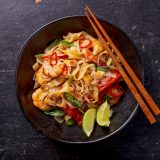Perfectly stir-fried noodles should walk a careful line between tender-chewy and gently seared. But this is a surprisingly challenging goal with dried rice noodles, a common choice for stir-fries in the U.S. Their tendency to readily absorb liquid easily yields mushy results. But with ample testing, we found we could turn that challenge into a strength.
We learned this while developing our recipe for pad kee mao, a spicy Thai street food classic of stir-fried rice noodles served “drunkard’s style.” Wide, flat rice noodles (known as kway teow) are tossed with a savory-sweet sauce punctuated by bursts of chili heat and peppery fresh basil. It turns out, the dish’s name offers a hint on how to prepare it.
In Thailand, so-called drunken noodles—a popular late-night food—are made with widely available fresh rice noodles. These noodles, which already are tender, can be used after just a brief toss with warm water. In the pan, they then readily soak up sauce, drinking in a combination of soy sauce, oyster sauce and fish sauce that forms the rich, complex flavor backbone of pad kee mao.
But fresh rice noodles can be hard to find in the U.S. So we tested numerous varieties and brands of dried rice noodles in our stir-fry, each time following package directions for how to prepare them prior to adding them to the pan. Most often, this involved either boiling the noodles or blanching them in very hot water.
And every time, we ended up with mushy, too-soft noodles that lacked much flavor in the finished dish. That’s because the noodles were waterlogged before they went into the skillet; they failed to absorb the sauce the way fresh noodles do, leaving us with a lackluster stir-fry.
After much testing, we decided to ignore the dried noodle directions. Rather than boil or blanch them, we gave them just a gentle soak in warm water, enough to make them pliable but not fully hydrate them. Meanwhile, we added water to our sauce—a blend of oyster, fish and soy sauces with a bit of sugar—just enough to finish hydrating our noodles as they cooked.
It worked. Once in the pan, the only slightly tender noodles readily absorbed our flavorful sauce. By the end of stir-frying, the noodles were perfectly tender, with just the right chew and tons of flavor.
With our noodles solved, we turned to the shrimp, which we also tossed in a blend of oyster and fish sauces, then cooked in two stages, allowing us to give them a proper sear without overcooking them. Copious fresh basil gives the dish sweet, peppery, herbal notes. A bright burst of squeezed lime echoes the mellower acidity of the tomato.
The finished dish packs in layers of sweet, savory and spicy—all without a single mushy noodle.
For Bigger Flavor, Water Your Sauce, Not Your Noodles!
Shaula Clark

Get the Recipe
Thai Stir-Fried Rice Noodles with Shrimp and Basil
For the best noodle stir-fry, stop boiling your noodles
Photo: Joe Murphy; Styling: Wes Martin






